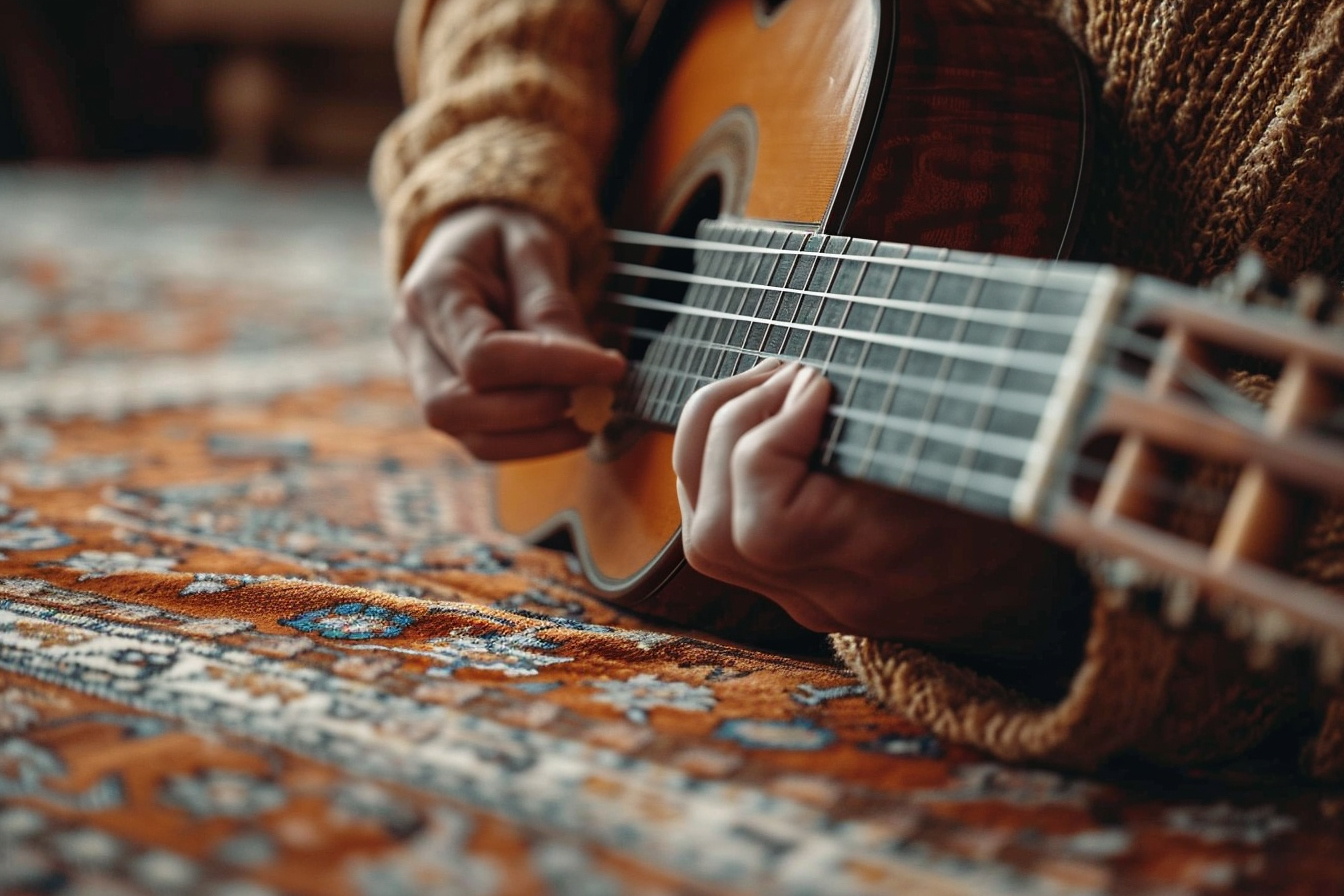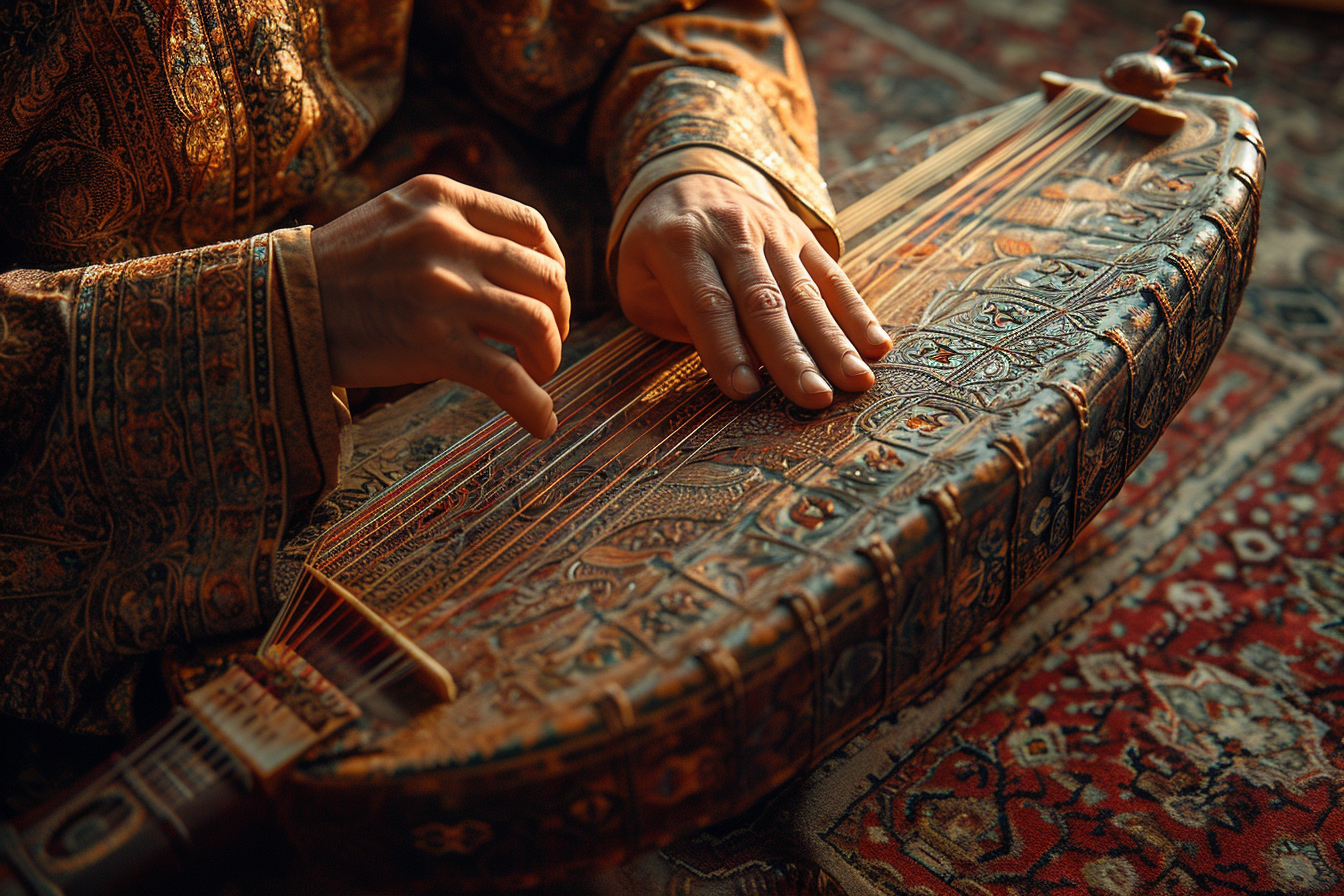
The Santour, an instrument with ancient roots in Persian culture, serves as a bridge connecting the past with the present in the realm of music. This instrument is a type of hammered dulcimer found in the traditional ensemble of Persian classical music. With its trapezoid-shaped body, the Santour comprises a multitude of adjustable strings that the musician strikes with delicate mallets, known as mezrabs. Each string resonates to unveil a rich tapestry of sound that is both captivating and complex, giving the Santour its distinctive voice.
Picking the right Santour can be a transformative experience for any musician. To fully understand and appreciate this instrument, one must dive into the nuances that contribute to its unique sound and playing experience.
The wood that echoes history
Selection of Timber
The essence of the Santour’s voice lies in the wood from which it is crafted. Traditionally, woods such as walnut, rosewood, and various types of maple are among the favorites for Santour makers. Each type of wood imparts a different timbre to the instrument; for instance, walnut offers deep, warm tones, while maple is known for its bright and clear sound.
Before selecting a Santour, it’s imperative for a musician to decide on the desired tonal qualities. The type of music one aims to play may guide this choice—classical repertoire might be better served by a Santour made of walnut, while contemporary pieces might shine on an instrument crafted from maple.
Quality of the Woodwork
The quality of craftsmanship that goes into creating a Santour is equally crucial. The instrument’s wood should be seasoned and treated properly to withstand temperature and humidity variations. Moreover, the precision of the joinery, the exactness of the string placement, and the meticulousness of the final assembly contribute significantly to the durability and sound quality of the Santour.
Understanding the santour’s string configuration
String Materials and Counts
Santours generally come with varying numbers of strings or courses, with each course containing multiple strings that are tuned to the same note. While most instruments have 72 strings, some may have up to 100, offering an expansive range of notes. The strings themselves are traditionally made of steel or copper, each bringing distinct properties to the instrument’s sound.
Tuning and Range
The arrangement of strings and their tuning affects the Santour’s range and register. When selecting a Santour, one must consider the types of musical pieces they wish to perform. A Santour with a wider range and more strings will enable the musician to delve into more complex compositions that require a broader swath of notes.
Mastery demands precision: the mezrabs and bridges
Mezrabs: Extensions of the Musician’s Will
The mezrabs play a vital role in articulating the notes on the Santour. Made from wood or metal, the choice of mezrab significantly affects the playability and response of the instrument. The weight, length, and balance of the mezrabs should feel comfortable in the hands, as they act as the direct point of contact between the musician and the strings.
Bridges: The Pillars of Sonority
The bridges of a Santour, or ‘kharak’, are precisely positioned to support the strings and transmit vibrations to the soundboard. These not only separate the strings to facilitate clear striking but also contribute to the tuning stability of the instrument. An experienced musician will listen closely to the purity of the intervals produced by the bridges, ensuring the Santour’s intonation remains true.
Beyond just sound: aesthetics and artistry
While the sonic qualities of a Santour hold paramount importance, the visual and tactile aesthetics should not be overlooked. Inlaid designs and motifs, often inspired by Persian art and history, can turn the instrument into a work of art. The choice of the instrument’s aesthetic complements the personal style of the musician and can be a source of inspiration during performances.
Investing in a quality santour: long-term considerations
Durability and Craftsmanship
A high-quality Santour is an investment. Meticulous craftsmanship ensures not only the tuning stability and sound quality but also the longevity of the instrument. Paying close attention to the construction methods, material selections, and the reputation of the maker will serve a musician well over time.
Maintenance and Care
Proper maintenance extends the life of a Santour and preserves its sound. This includes regular tuning, careful handling, and safeguarding the instrument from extreme environmental conditions. When selecting a Santour, one must also factor in the ease of maintenance, access to knowledgeable luthiers, and the availability of spare parts like strings and mezrabs.
Connecting with the instrument: test before you invest
Personal Connection and Comfort
Comfort and personal connection cannot be underestimated when selecting the perfect Santour. It’s essential to spend time with the instrument, understanding how it feels and responds to touch. The weight distribution, the action of the strings, the mezrab’s grip—all these aspects synergistically contribute to the ease with which a musician can express themselves.
Advice from Masters
Seasoned players and teachers can provide invaluable guidance based on their own experiences. Consulting with experts can lead to insights into the particular characteristics and idiosyncrasies of different Santours. These may include recommendations on specific brands, configurations, and maintenance practices.
The evolving landscape of santour selection
Innovations and Adaptations
Innovations in Santour design and construction techniques have brought about variations that cater to different playing styles and sonic preferences. For instance, some modern Santours feature adjustable bridges or dampening mechanisms. Understanding and embracing these innovations can open new avenues for creative expression.
Global Availability and Access
With the globalization of music, the Santour has transcended its traditional boundaries, making it more accessible worldwide. This also means that prospective buyers have a larger pool from which to select their instrument. However, it’s crucial to ensure that the selected Santour resonates with the deep cultural roots and tonalities of Persian music.
The role of the santour in ensemble and solo performances
In ensemble performances, a Santour must blend with other instruments, complementing rather than overpowering the collective sound. The dynamic range and tonal versatility of the Santour need to fit within the greater tapestry of the group’s performance.
Conversely, in solo performances, the Santour becomes the centerpiece, showcasing the musician’s virtuosity and the instrument’s rich sonority. The selection process must, therefore, address the Santour’s ability to stand alone while captivating the audience with its melodic and harmonic potential.
Educating the next generation of santour players
Preserving the traditional methods of playing and caring for the Santour is essential in educating budding musicians. Yet, one must also recognize the importance of contemporary practices and diverse musical influences that enrich the instrument’s evolution.
Mentorship, regular practice, and continued learning are key to mastering the Santour. The instrument chosen by an emerging musician becomes a companion on this journey, growing and evolving with them as they explore the depths of Persian music.
Continual exploration: the unfinished journey
Selecting the perfect Santour is not the end but the beginning of a lifelong journey of musical discovery. The relationship between the musician and the instrument develops over time, with each performance adding layers of understanding and depth to the sound.
Innovation, cultural appreciation, and technical mastery interweave to shape one’s trajectory in the world of Persian music. The Santour, with its rich heritage and expressive potential, challenges and rewards its player, beckoning them further into the realm of musical excellence.
As we have unraveled the complexities involved in selecting the perfect Santour, we find ourselves at the intersection of tradition and modernity, of personal expression and cultural legacy. Every Santour possesses a story waiting to be told, a melody waiting to be discovered, and a bond waiting to be formed with its player.
This narrative continues to unfold in the hands of each musician, promising an infinite palette of musical possibilities. The pursuit of mastery is not merely an exercise in technical prowess but a commitment to carrying forward the echoes of an ancient tradition through the delicate strikes upon the strings of the Santour.
The search for the perfect Santour is a testament to the timeless allure of Persian music and its ability to captivate the hearts of those who encounter its subtle grace and profound beauty.

